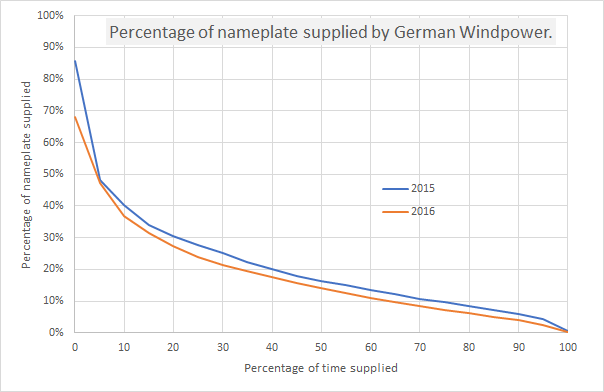GRA said:
That being said, the low capacity factor of VRE compared to the typical fossil-fueled plant means that generating capacity would have to increase by about 2.5 times for U.S. electricity to go completely renewable, plus all the new power transmission lines to get those renewables to the public, combined with cheap storage which doesn't yet exist (except in a few places where PHES will work). Smil and others have done the calcs, and IIRR it would take an expansion of land use for energy extraction. generation, transmission etc. at current RE power densities from about 0.5% of total U.S. land area to about 50.0% to go fully renewable (for all primary energy IIRC, not just electricity), which simply isn't realistic.
That 50% land use figure is nonsensical. Can't you google a little and do trivial arithmetic ?!
I showed earlier in this thread that it will take ~ 2 TW to replace the fossils currently used in the US for electricity and transport.
Half of that can be rooftop, so 1 TW new land use.
Arithmetic (a lost art):
1.6 meter squared per kW http://www.suncyclopedia.com/en/area-required-for-solar-pv-power-plants/
2*10^9*1.6 = 3.2 * 10^9 square meters
US land area: ~ 4
million square miles = 10^13 square meters
That is before we consider conservation, improvements in panel efficiency, and off-shore wind production
----
But maybe the arithmetic is wrong ? Lets try some simple per capita numbers:
US population: 325 million
US land mass: 10 * 10^12 square meters
Land mass per capita: ~ 3 * 10^4 square meters
1% land use ? 300 square meters per capita.
My household uses under 3 square meters per capita to cover electricity and personal transport. I could triple my generation by adding panels to the roof.
---
Why not -- another simple exercise:
Panel efficiency of 20%
Utility scale capacity factor of 25%
Insolation of 1000 watts per meter*meter
-> 50 watts per meter*meter = 50*365*24 Wh a year per square meter PV = 438 kWh per year per square meter
Current US electricity generation from fossils is ~ 2.5 * 10^12 kWh a year
5.7* 10^9 square meters. If half is rooftop then ~ 2.85 * 10^9 square meters of 10^13 US land mass ... before accounting for wind, both on and off-shore.
----
Come on !

